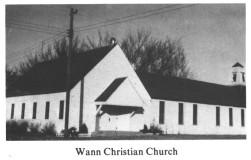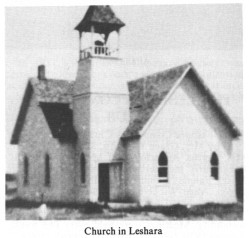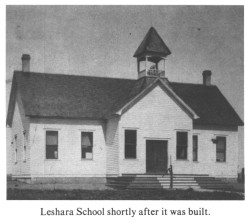 |
MARBLE PRECINCT |
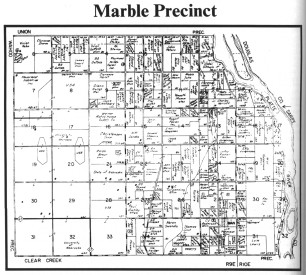 |
| (image links to larger map) |
MARBLE PRECINCT
Marble Precinct, in eastern Saunders Co., is bounded on the east by the Platte river; south, west and north by Clear Creek, Wahoo and Union precincts. Its only town is the village of Wann located in the N.W. corner of Sec. 36 on the Ashland-Fremont-Sioux City branch of the C,B&Q RR. The soil is excellent, and produces annually some of the finest crops in the entire county.
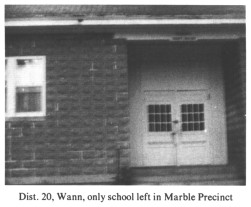 |
| Dist. 20, Wann, only school left in Marble Precinct |
The precinct was formally organized Feb. 1, 1871. It was created out of parts of Clear Creek and Union precincts.
Today it contains the National Guard Training area, the University of Nebraska Field Laboratory and the U.S. Military Reservation. Several creeks run through the precinct, Clear Creek cuts down thru from north to south. The Ordinance Plant was created out of the western half of the precinct in 1942.
Precinct officers for 1983-87 terms: Chairman -- Roger Allington, Clerk -- Larry Karloff, Treas. -- Wayne D. Drew.
Marble Precinct received its name from Andrew Marble, the first judge in Saunders County from 1866-70. He first moved to this area in 1864 and proved up on his homestead in 1869. Five of his children are buried in the Ashland Cemetery. He was a breeder of Poland China hogs.
Wann is the only town in the precinct. Submitted by Mrs. Don Graham
HISTORY OF WANN
(taken from Bicentennial Schools of Saunders
County)
No fancy yachts or ocean liners dotted the great sea to the east as families left their homelands to make a new life in the New World. People like the Williams, Wilsons, Grimes, Evermans, and Lavertys were on their way to the new world from such places as England, Ireland, Scotland, and Germany. It is of the sons and daughters we wish to write in our history.
As far as we can find out the Andrew Allen Wilson Family was the first family to settle in the Wann community. Some of the Saunders County histories say it was within a short time after the Homestead Act of 1862. We are told that it was between 1865-1870 that there were eleven children in the Wilson family.
An interesting fact passed on to us by Nellie Lohry was that Joseph, a step-brother, went out West and was among those who surveyed Yellowstone Park. They were also told that her father hauled logs from near the Platte River to build his log cabin. The family homestead was located one-half mile east and a short distance north of the church. The Wilson name has been carried through seven generations in Wann.
Dennis Grimes' parents came to Pennsylvania from Ireland in 1853, one year before Dennis was born. It was here that he grew up and received his formal education. At the age of 23, feeling that Pennsylvania was becoming a bit too thickly populated, he made his way westward to Saunders County near the Platte River because of plenteous rainfall and good fertile soil. He later sold his homestead and purchased another tract of land, some 650 acres which he greatly improved. It was located on what we know to be the Glen Newsham residence up until recently. Glen has purchased the former Pete Nitz farm. Mrs. Nitz was a daughter of Nellie Wilson Lohry.
page 80
The farm which was the Jesse Becklehymer homestead was located on the south side of the road, about a mile east of the church.
The A.R. Williams family came to Wann about 1868 from Pennsylvania when Mary (better known as Grandma Decker) was less than a year old. They, like most of Wann's first families, feeling that there was not enough elbow-room in the East, pushed westward. There were six children born to this family. Mrs. John Vosler, who lives in Ashland, is a daughter of Margaret Williams, Mrs. M.L. Williams. This family lived on what is known as the Ludden farm.
In the early part of the 1870's another family, the Alvin Lavertys, whose parents came from Scotland to settle in the East, made their way westward and settled near the Platte River east of Wann. Mrs. Laverty was the daughter of A.R. Williams. It seems that Alvin did quite well at this location, raised a family and became quite well-to-do. Because his wife felt that the little house in which they resided was not quite adequate in keeping with their financial status, they decided to improve on it. During the hardships that followed, they were unable to keep up their improved dwelling. Quite a number of the older generation in and around Wann recall working as hired hands on the Laverty farm, helping cut hay and other farm duties.
What we now know as the Don Keetle Place was once known as the Bill James residence. We are not able to find any more information on their family.
Let us now turn our attention to Schleswig-Holstein, Germany where the family of Henry and Catherine Miller are embarking on their journey to the New World. It is believed that they settled in Pennsylvania. Around the latter part of the 1870's, a son, Nicholas, made his way westward to Saunders County, Nebraska; settling about six miles north-west of Wann. He was a cattleman, raising both beef and dairy cattle. He had a cream station which he operated until shortly before the town of Wann came into existence. We wonder, was Nick Miller named for his great grandfather. The first Nicholas Miller was the grandfather of Wann's Glen Miller.
We were unable to find much information on the Jim Smith family. They settled on a farm about three miles from the old schoolhouse, which was located near the present farm of the Rieckens.
George and Rose (Wilson) Everman settled on what later became the Burt Wells farm. They were the parents of our good friends and neighbor, Roy Everman. Mr. and Mrs. Roy Everman lived just south of the schoolground recently purchased by Mr. and Mrs. Gus Han. (Now owned by Buckleys).
These settlers, of whom we have just written, came west by covered wagon or by train from the eastern states in which they were born. We realize that there were many more pioneers who braved the hardships of traveling west, but due to limited time and space, we decided to keep our initial history within a span of the first ten years of the settling of Marble Precinct. We will briefly mention a few more of the others who came between 1880 and 1900. Among those were: William Lehr, Joseph Moss, Lewis Linebaugh, Martin Schupe, M.L. Williams, the George Washburn family, and the George Draper family, as unfolds the importance of
these families.
The first seven or eight pioneer families, about whom we have already written, realized that there were two elements which are very important to life and endurance of any enterprise. They are: religious worship and education. To carry out these major projects, a schoolhouse was built about one-half mile east and one mile north of the present location. Here began the education of the pioneer children. It was here that these seven families met for worship. Realizing the need for a better place of worship, they decided to take up a collection for the building of a church. Not wanting to go in debt for the building, they spent only what they had collected. The school and church, as in the beginning of Wann's story, are still the mainstays of the town and community.
The beginning of every enterprise such as a village a town or a city depends upon an industry, a natural resource, geographic location, or its climate. Wann was no exception to this rule. The Sioux City and Western Railroad Company felt that the land through what is now Wann was the only place for the railroad to be built as it stretched its way to Sioux City. Anticipating the building of a town here because of its settlers and pioneers, they bargained with Andrew Wilson for ten acres of land to be used for the railroad right-of-way and a town when it came into being. The transaction was completed with the stipulation that there would never be any liquor sold within its limits. The railroad company also gave Mr. Wilson the privilege of naming the town when it was built. They suggested the name "Wilsonville" but Mr. Wilson, feeling that it would never be a large town, thought a small name should be given to it. The railroad then submitted to him a large sheet of town names. Seeing the name of Wann, he decided on it, a small name for a small town and the "W" would stand for Wilson.
By 1905, the townsite was laid out in lots ready for sale and the railroad was finished. Workers from many different places and of different nationalities had a part in the building of the railroad through Wann. The project was not without incident. We were told that one worker (some say Mexican, others say he was Italian) was murdered before the railroad was finished. It seems he was stabbed and dumped in the creek near what used to be the George Everman homestead.
Considering the importance of the church in Wann, let us go back to the time before the Wilsons, Williams, or any of the settlers had set foot west of the Mississippi River as late as 1866. In around 1860 a minister made his way westward and decided that here would be a good place to start a church. Because of the Indian skirmishes, he was forced to give up the idea and returned to Pennsylvania. Then in the 1880's when the church was completed under the direction of their minister, Rev. Kirchsteen, they took in many members. The church was called the Pleasant Valley Church of Christ. It was located across the road north from the present location to which it was moved in 1906. The second minister who came in 1902 was E.M. Johnson, a student pastor. In 1928 another room was built on the south. As time went by a kitchen was added. Then in 1942 work was begun on the chapel, although plans for it had been drawn up some years earlier. The work of the chapel was carried out under the patronage of Sherman Hanson and completed in 1943, free of debt. When the room was added to the south in 1928, the original part was to be used as Sunday School rooms and as a social and dining room unit.
We were told that in those early years a part of the community's entertainment was home talent plays held in the social hall of the church. Other forms of recreation included quilting bees, spelling bees, picnics, and carnivals. As a note of interest, it seems that at the picnics most of the children had ponies and as part of their fun would race with one another. The best part came when the fathers would become interested and began betting on the ponies.
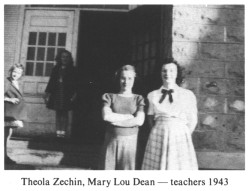 |
| Theola Zechin, Mary Lou Dean -- teachers 1943 |
Second in importance came the school. In the earlier years the school was located about one-half mile east and one-half mile north of the church corner. It was a one-room building. Then, in 1907, work was begun on the new school where three districts combined. It was built at the present location. It was built with three rooms; primary, upper-elementary, and the first two years of high school. The high school was discontinued in the early 1940's but we are still holding school for the other two divisions. Building on the new school began in the spring of 1908 with the expectation of having it ready for occupancy that fall. It was not finished until Christmas time, so school began in the fall of 1908 with classes held in what is now the church hall. Heating the schoolhouse was done by means of pot-bellied stoves. Transportation was provided the children by means of two horse-drawn school buses which were heated by pot-bellied stoves.
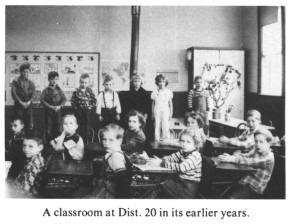 |
| A classroom at Dist. 20 in its earlier years. |
Another worthwhile enterprise which has endured throughout the life of our town was the Platte Valley Ladies Aid. It was organized by the ladies of the community at the home of Mrs. Alvin (Olive Wilson) Laverty in 1905 for the benefit of the ladies ofthe community. In later years the name was changed to the Wann Ladies Aid.
The Ashland Gazette was responsible for the circulation of the Platte Valley news which was printed as a column. The news was written and submitted by Lewis Linebaugh until the column was discontinued.
The women in the days Wann was settled wore long floor-length dresses with high collars. Most of them wore high top button shoes. The businessmen of those days mostly wore suits and the farmers wore heavy homemade shirts and pants with suspenders. The children also wore homemade clothing, all quite a far cry from the clothes of today.
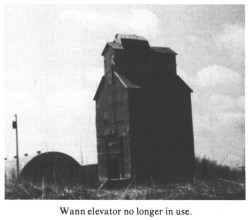 |
| Wann elevator no longer in use. |
This brings us to the final gate of Wann's history as we see it today, the present day happenings. She no longer boasts of business enterprises or industries as in the days gone by, but the channels through which her life blood began to flow so many years ago are still the same as they were at the beginning, the church and the school. They are still the foundation on which the town of Wann still builds. The threads have been well-woven, those of religious worship and education for all. We hope we have succeeded in recalling to mind the importance in our lives of our heritage.
The years have come and gone and time and change have taken their toll but we hope that the pages our history of Wann have proved that she still has a soul.
The seventies brought changes to the school. Central heating and indoor plumbing were added.
page 81
Extensive redecorating took place in 1976. The children were transported to school by two vans driven by Mrs. Edith Vosler and Mrs. Kenneth Rogers for a number of years. A 36-passenger bus replaced the vans with Kenneth Rogers, George Ohm and Mr. Buckley as drivers. The enrollment at the Wann School in 1982-83 is about 25 pupils, with Lori Blum and Laura K. Anderson, teachers.
Some family names of Wann residents are Bogatz, Richards, Buckley, Vosler, Schnick and Newsham.
The Wann Christian Church closed its doors in 1979 but the Wann Ladies Aid is still active. Several Omaha families maintain summer homes on the stream and ponds west of Wann.
 |
| Pupils, Teachers, Wann Sch. Dist. #20, 1982-83 |
| 
